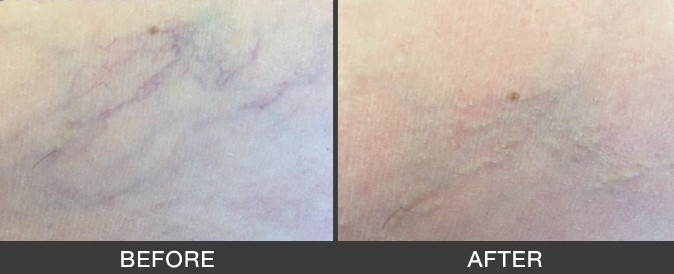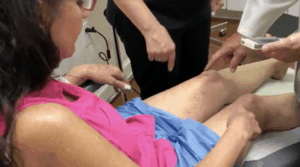Sue, a sclerotherapy patient at the Vein Care Center of Amelia Island, was determined not to let spider veins adversely impact her quality of life.
Spider veins can deal an enormous blow to one’s self-esteem, confidence, and self-image. People with spider veins often feel ashamed about their legs and feet and may avoid showing them in public at all costs.
Sue’s spider veins were preventing her from enjoying life to the fullest, and her embarrassment around the condition was creating stress and trepidation about her upcoming vacation to the tropics. It was then that Sue decided to take matters into her own hands and get sclerotherapy treatment for her spider veins.
After doing some research online, Sue turned to the expertise of Gabor Kovacs, M.D., F.A.C.S., a board-certified vascular and general surgeon at the Vein Care Center of Amelia Island. “I came to Vein Care Center of Amelia Island to get treatment for my spider veins, and it was an excellent decision,” says Sue. “The biggest benefit of my sclerotherapy treatment is that many of the spider veins have disappeared. I feel more comfortable when I wear shorts to go outside.”

What Are Spider Veins?
Spider veins are tiny veins that congregate just below the surface of the skin causing red, purple, and blue discolored patches. The flooded capillaries wind their way around the thighs, feet, and legs giving them a spider or tree-like appearance with their short, jagged lines.
The causes of spider veins are not completely clear; they can be hereditary and have also been linked to pregnancy, using birth control pills, and weight gain. Some instances of spider veins can be mild while others are more apparent. They occur more often in women than men and may be associated with pain, swelling, or an itchy rash. Although generally harmless, spider veins can generate intense feelings of self-consciousness and embarrassment.
“I’ve always been self-conscious of my legs because I have a lot of spider veins,” says Sue. “They are hereditary, and I always worked (at jobs) on my feet, so I was self-conscious about wearing shorts and showing my legs.”
Treatment for Spider Veins
In cases where patients have no negative symptoms and do not mind the presence of spider veins, medical intervention may be unnecessary. To keep the veins robust and radiant, a vascular surgeon may recommend smart lifestyle choices including:
- Regular exercise
- Losing weight
- Avoiding tight-fitting clothing or high heeled shoes
However, when symptoms of discomfort, inflammation, or other complications arise, or when a patient wishes to remove spider veins for cosmetic reasons, medical treatments may be justified. They include:
- Compression stockings – to inhibit blood from accumulating down in the legs.
- Ablation therapy – injection, radiofrequency or laser treatment to close or remove the veins.
- Sclerotherapy – may be recommended when a vein is twisted and more complex.
“We were planning a vacation to Hawaii and the Bahamas,” says Sue. “And I wanted to be able to wear shorts in the beautiful tropical weather. However, I was really self-conscious about my spider veins. We went online and saw that Vein Care had five stars, so we decided to come here and get our treatments done.”
 How Is Sclerotherapy Performed?
How Is Sclerotherapy Performed?
Treatment for spider veins is typically done in the vascular surgeon’s office and is completed in about an hour without the use of anesthetics. Depending on the size and scope of unhealthy veins, sclerotherapy can significantly improve the look of varicose and spider veins in the thighs, calves, ankles, and feet.
More often than not, sclerotherapy is deemed cosmetic by most insurance companies; therefore, patients may not be covered automatically and should confirm their exact coverage with their insurance provider.
Patients lie on their back with the feet elevated above the knees. The vascular physician will clean and sterilize the treatment area, and then will use a tiny 30-gauge needle into the vein. A sclerosing solution will be injected into the blood pathways causing the vein to shut down, spasm, clot, and disappear. Over time, the vein will scar and fade away, turning white and dissolving into the surrounding tissues. Patients have to understand that results are not instantaneous and sometimes several sessions are required to get rid of a cluster of spider veins.
“The staff here are so friendly and welcoming,” Sue continues. “They almost feel like family. They treat you with TLC if you’re a little nervous and help to ease your anxiety. They lead you through the procedure each step of the way. I know some people are afraid of needles, but it’s not that bad. Sclerotherapy feels like a little pinprick, and they make it easy and comfortable so you can relax and have your procedure done.”
Recovering After Sclerotherapy
After sclerotherapy treatment, most patients are able to return home right away and resume their regular activities within a day or two. Staying active and keeping the legs mobile is essential to prevent blood clots from forming. However, patients should avoid strenuous exercise for at least two weeks after sclerotherapy.
Research has shown sclerotherapy to have a 60-80% success rate for eliminating spider veins. Less than ten percent of patients show no progress at all, in which case, other chemical options can be employed. Many patients will see an immediate improvement just a few days after treatment. However, the full effects of sclerotherapy may not become evident until a month or two after each session.
Thanks to her successful sclerotherapy treatment, Sue can now proudly wear shorts on hot summer days without feeling self-conscious or embarrassed. “Now I can go out in public and wear shorts if I want to,” she says. “The weather’s warmer and you don’t want to wear pants. After the treatment, it’s just so beneficial and rewarding to be able to have fewer veins showing on your legs.”
